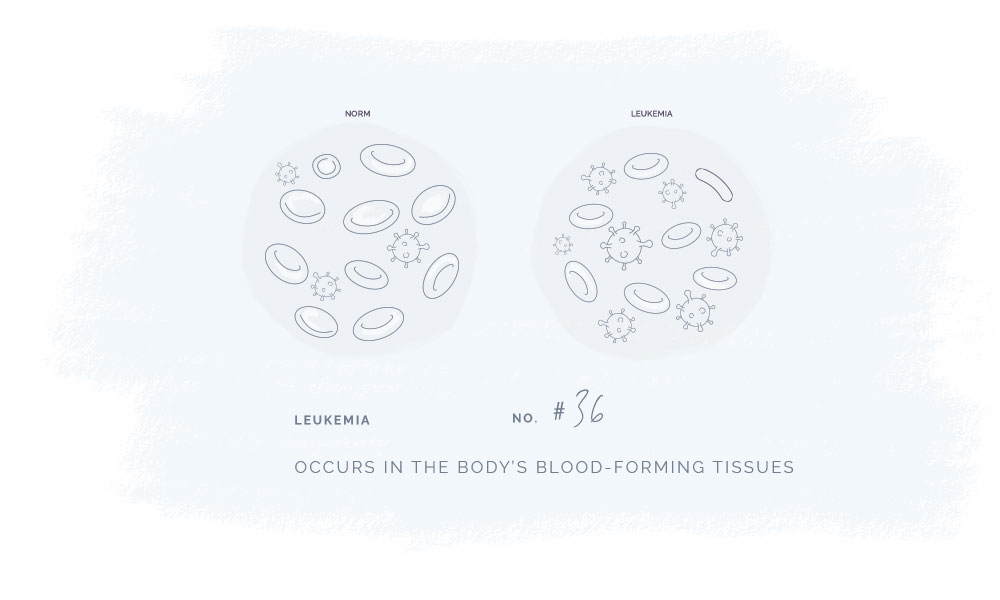Leukemia
Category
Cancer
REVIEWED BY
Our Biomedical Scientist
Reviewed based on
Literature Discussion & Clinical Trials
Last update
October 2020

What is Leukemia
Leukemia is a group of cancers that begins in the body’s blood-forming tissues, including the bone marrow and the lymphatic system.1
The lymphatic system is a network of tissues, vessels, and organs with important functions to keep the body healthy by shielding it from diseases caused by foreign intruders, maintaining body fluid levels, transporting, and removing waste products, among others.2
White blood cells play an important role in fighting infections. However, white blood cells produced by the bone marrow become abnormal in people suffering from leukemia which may cause them to divide too fast, crowding normal cells.1
Symptoms
As leukemia is a group of cancers, the symptoms can vary depending on the type of leukemia. However, the following main symptoms are:
- Persistent fatigue
- Swollen lymph nodes e.g. enlarged liver or spleen
- Frequent severe infections
- Unintended weight loss
- Pain or tenderness in bones
- Fever and chills
- Easily bruising and bleeding
- Excessive sweating (especially at night)
Cause
As other types of cancer, leukemia involves the growth of abnormal cells which contain mutations leading to uncontrollable cell division and growth. Similarly, it can spread and damage/destroy normal tissue.
Up to this date, it is not clear what is the exact cause of leukemia. It is suggested that a combination of genetic and environmental factors can play a role in the development of this type of cancer.
In general, it is believed that leukemia can occur when some white blood cells acquire mutations in their DNA, or due to other not-yet-identified changes in the cells.1
Factors that can increase the risk of developing leukemia are:
- Previous cancer treatment
This can include certain types of chemotherapy and radiation therapy - Genetic disorders
This can include Down Syndrome - Certain chemical exposure
- Smoking
- Family history of leukemia
The connection between Cannabinoids & Psoriasis
Studies find that CBD and THC may have great therapeutic potential and may be used to help treat Leukemia. CBD and THC are well-known cannabinoids, however, they do not have the same psychoactive effects. THC is psychoactive while CBD does not possess psychoactive effects. According to WHO guidelines, the cannabidiol CBD is generally well tolerated with a good safety profile.
Preclinical data suggest that the cannabinoids THC and CBD may be therapeutic in the treatment of leukemia.3
For example in animal models and in culture, cannabinoids have been observed to suppress tumor cell growth through modulation of key cell-signaling pathways.4
Please refer to the general cancer entry for more information.
The literature discussion is an overview of the published results from scientific studies investigating if and how cannabinoids can be beneficial in the treatment of Leukemia. The overview will be updated regularly to ensure the newest and most accurate information.
CBD, THC and cannabinoid receptors may oppose great potential in the treatment of Leukemia cells
Functional CB1 and CB2 receptors are expressed by leukemia cells with THC being the most studied cannabinoid in leukemia treatment.5
Several studies showed that THC exerts cytotoxic effects triggered by apoptosis in leukemia cells.6,7,8
Intrinsic pathways involving ceramide-dependent mitochondrial stimulation may mediate this apoptosis .9,10
Furthermore, other CB1/2 antagonists were found to suppress the growth and proliferation of leukemia cells.11,12
CBD, which has shown to exhibit anti-inflammatory and immunosuppressive activity, also can help induce activation of mast cells.13
Clinical trials are research studies that examine new treatments and evaluate their effects on human health outcomes.
Cannabis oil decreased leukemia cells in clinical case
In a clinical case, it was shown that leukemia cells decreased when cannabis oil was used to treat a 14-year-old patient suffering from acute lymphoblastic leukemia (positive for the Philadelphia chromosome mutation).4
- https://www.mayoclinic.org/diseases-conditions/leukemia/symptoms-causes/syc-20374373
- https://www.healthline.com/health/leukemia
- https://ghmedical.com/endocannabinoid-system/diseases/leukemia
- Singh, Y., Bali, C., (2013). “Cannabis Extract Treatment for Terminal Acute Lymphoblastic Leukemia with a Philadelphia Chromosome Mutation” https://www.ncbi.nlm.nih.gov/pmc/articles/PMC3901602/
- Moaddel, R., Et Al., (2011). “Development and characterization of immobilized cannabinoid receptor (CB1/CB2) open tubular column for on-line screening”. https://pubmed.ncbi.nlm.nih.gov/21215722/
- Herrera, B., Et Al., (2005). “p38 MAPK is involved in CB2 receptor-induced apoptosis of human leukaemia cells”. https://pubmed.ncbi.nlm.nih.gov/16139274/
- Jia, W., Et AL., (2006). “Delta9-tetrahydrocannabinol-induced apoptosis in Jurkat leukemia T cells is regulated by translocation of Bad to mitochondria”. https://pubmed.ncbi.nlm.nih.gov/16908594/
- Lui, M.W., Et Al., (2008). “Enhancing the in vitro cytotoxic activity of Delta9-tetrahydrocannabinol in leukemic cells through a combinatorial approach”: https://pubmed.ncbi.nlm.nih.gov/18608861/
- Herrera, B., Et Al., (2006). “The CB2 cannabinoid receptor signals apoptosis via ceramide-dependent activation of the mitochondrial intrinsic pathway”. https://pubmed.ncbi.nlm.nih.gov/16624285/
- Lombard, C., Et Al., (2005). “Targeting cannabinoid receptors to treat leukemia: role of cross-talk between extrinsic and intrinsic pathways in Delta9-tetrahydrocannabinol (THC)-induced apoptosis of Jurkat cells”. https://pubmed.ncbi.nlm.nih.gov/15978942/
- Gallotta, D., Et Al., (2010). “Rimonabant-induced apoptosis in leukemia cell lines: activation of caspase-dependent and -independent pathways”. https://core.ac.uk/download/pdf/191524795.pdf
- Yrjölä, S., Et Al., (2015). “Synthesis, in vitro and in vivo evaluation of 1,3,5-triazines as cannabinoid CB2 receptor agonists”. https://researchportal.helsinki.fi/fi/publications/synthesis-in-vitro-and-in-vivo-evaluation-of-135-triazines-as-can
- Guidice, E., Et Al., (2007). ” Cannabidiol, unlike synthetic cannabinoids, triggers activation of RBL-2H3 mast cells”. https://pubmed.ncbi.nlm.nih.gov/17339608/
CANNABINOIDS & RECEPTORS
Below you find the plant cannabinoids, cannabinoid receptors, and endocannabinoids that are associated with the potential therapy.
If you have any further information relevant to the connection between Leukemia and cannabinoids or find any of the information inaccurate, outdated or incomplete please contact us here.

